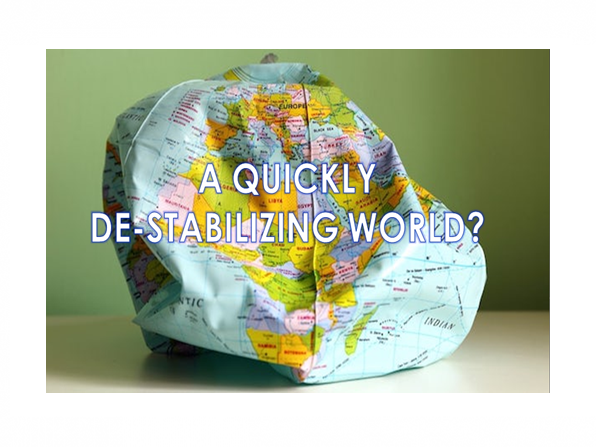IN-DEPTH: TRANSCRIPTION - UnderTheLens – 06-22-22 - JULY – A Quickly Destabilizing World
SLIDE DECK
TRANSCRIPTION
SLIDE 2
Thank you for joining me. I'm Gord Long.
A REMINDER BEFORE WE BEGIN: DO NO NOT TRADE FROM ANY OF THESE SLIDES - they are COMMENTARY for educational and discussions purposes ONLY.
Always consult a professional financial advisor before making any investment decisions.
COVER
The global issues appearing daily can leave few with any other feeling than the world is quickly de-stabilizing! This is not some sort of the “world is coming to an end” statement, but rather an observation regarding how rapidly threatening events are occurring, that if not managed properly and on a timely basis, could easily spin out of control and cause serious unexpected consequences!
Last week the ECB convened a rare emergency meeting only days after its regular meeting and then refused to make any statement on the reason for it.
In parallel we have the markets “a buzz”, as a major player has taken a short against the Japanese Yen that could only be comparable to the size George Soros historically took against the UK pound before it collapsed.
We have major Hedge Funds now stopping redemption flows. On Thursday the third largest short volume on the US S&P 500 was placed. The dollar can’t stop rising in a global flight to safety … and the list goes on.
Something is broken somewhere but many suspect it is currently being kept under wraps to stop the markets from unraveling too quickly.
AGENDA
What is at the core of the instability is the increase in the global money supply since the 2008 Financial Crisis versus the weak expansion of real global economic growth. The global economic system was fragile, unbalanced, over-indebted and excessively leveraged before Covid. Then Covid-19 hit.
The reaction to Covid in pumping a further $29T into the global economy while effectively shutting down the productive element through lock-downs was an impulse that ignited raging global inflation.
It was like a spark in dry kindling, where inflation had not existed; suddenly it upended the financial credit and lending systems. Like an earthquake, the damage takes awhile to be felt and only now is the true force being realized. Like a forest fire it can quickly get out of control. The mistaken policy belief that Inflation was “transitory” delayed the reaction function and allowed the fire to burst onto the global stage as a financial incinerator!
The question is whether global policy leaders can wrestle it under control??
I want to cover the subjects listed here to give you a better idea of the clear warning signs we are being given, that everything is not as rosy as our leaders want us to naively believe!
SLIDE 5
Let’s start with the data and what is actually happening, versus what the media thinks or wants us to believe is occurring.
SLIDE 6
Since the beginning of the year we have experienced the largest “give-back” of paper wealth – IN HISTORY!
The total value of stocks and bonds losses combined is over $15T globally.
Remember, this is after injecting $29T global in response to Covid-19.
SLIDE 7
Global Sovereign bond losses are on course to experience the biggest loss since 1920.
Anything even close to this marks a seminal event in world history.
We need to appreciate that the Basel Accord demands banks immediately adjust their loans outstanding and investment portfolio to offset the banking risk that lower bond prices create structurally. There are therefore massive re-adjustments that are occurring out of sight. These forced adjustments are no doubt causing serious problems for both over-extended lenders and borrowers.
SLIDE 8
I continually discuss in these videos that Credit always leads market turmoil. Equity market collapses are always a credit event!
As bad as the damage has been so far in the global equity markets, capitulation in the form of cumulative flows has only so far been realized in the Credit Markets. Seldom, if ever, have I seen the equity markets not follow the credit flows!
SLIDE 9
The dislocations in the reduction of negative yielding bonds outstanding are truly stunning. As yields rise the approximately $18T in negative yields had to absorb unprecedented capital losses. A lot of these holders were not regulated banks operating under Basel VaR requirements, but rather institutions and shadow banks likely highly leveraged.
SLIDE 10
This chart of the US High-Yield or JNK Bond Markets is as graphical a representation as any of a market that is broken and steadily collapsing!
SLIDE 11
The Global Risk Free Benchmark which is considered to be the US 10Y Note is shown here based on the increase in yields.
The benchmark doesn’t rise this fast unless it is signaling major monetary policy mistakes are occurring. It is significantly ahead of the Federal Reserve and its Fed Funds Rate as well as seriously behind the rate of inflation!
SLIDE 12
Investors around the world are scared and are looking for places to protect their money. The US Dollar or Eurodollar has normally been the quickest destination.
It has been a long time since the US Dollar rose at an exponential rate!
SLIDE 13
Besides the data we have:
- A major War in Europe, not seen since WWII,
- A Structural Global Energy Crisis that seems only to get worse with no solution in sight,
- A looming Global Food Crisis,
- Collapsing Residential and Commercial Real Estate due to mortgage rates doubling,
- Global Shortages across the Supply Chain which has yet to feel the Chinese lockdowns of 400M people in its industrial heartland and key import / export ports.
This is about a depressing a picture as I can recall seeing, since getting into this line of work a few decades ago!
SLIDE 14
The central problem is there are no actions being taken to solve any of these problems by global elected politicians. They seem overwhelmed and incapable of any form of coordinated action.
As you would expect with politicians they have settled the solution to the economic problems with their Central Banks.
Central Banks are equipped to solve Demand problems. They have never been tasked nor have any expertise in solving Supply problems where a lot of the problems with inflation and shortages stem from!
Therefore let’s briefly examine what the key Central Banks are doing, the challenges they face and whether there is any possibility of the central bankers halting these crises before the momentum and unintended consequences overwhelm the global system.
A system that at best could be described as “Fragile”!
SLIDE 15
The Federal Reserve increased the funds rate by 75bps last Wednesday to 1.5%-1.75% during its June 2022 meeting. This was instead of 50bps that had previously been expected, until the CPI and PPI rates came in at blazing hot readings and M-o-M increases - increases which have signaled that inflation is still accelerating upward.
The red line overlaid on this long term S&P 500 chart shows the history of the Fed Funds Rate. The dotted red line shows the maximum it was able to be increased by before the Fed was forced to reverse direction.
You can see on the left axis this is exactly where we are now after a panic 75 basis hike on Wednesday.
What are the chances of the Fed continuing at this rate or even a shallower 50 point rate in the next two summer meetings?
SLIDE 16
This chart shows that every prior time the Fed reversed policy, it was because it broke something serious which took the economy into a nose dive and the Fed couldn’t lower rates fast enough to mitigate the damage.
Will this time be any different? Since this chart goes back 5 decades, the chances are good that it will repeat in some fashion.
Maybe something has already broken and it is being contained – like the ECB emergency meeting or Japan’s unlimited buying of any BOJ treasury instrument they can create!
Maybe it will take another hike or two – however it seems inevitable. Certainly the bond market is signaling this and the fact it believes the Fed has its Monetary Policy wrong. You don’t tighten when the economy is slowing down. You don’t raise rates nor reduce the Central Bank’s balance sheet when you are staring down the barrel of a recession!
SLIDE 17
The Fed is swinging from delayed lift off to over-tightening. In my studied opinion, the Fed should have begun tightening the moment Biden assumed power, begun spending programs and tried to pass others all measured in the $Trillions.
Something we have never done and bigger than the cost of WWII!
SLIDE 18
The well respected Financial Managers Survey clearly shows that professional money managers believe the Fed has it wrong (for whatever reason) and sees it as the biggest potential risk to financial market stability.
We believe the Fed knows full well it will never implement QT to any real degree before it reverses. It is once again “jaw boning” but few are paying much attention to them!
SLIDE 19
Clearly investors are nervous and we can soon expect global equity flows to reverse negatively and likely aggressively to the downside!
SLIDE 20
Obviously, we don’t see the Fed coming to the rescue of the world problems - at least not until something breaks and they have the political cover to reverse their strategy.
What about the EU and ECB?
SLIDE 21
Christine Lagarde and the European Central Bank are currently in a pivotal position.
The ECB had been resolutely more dovish than its counterparts, and far more reluctant to embark on trimming its balance sheet or raising rates. That has changed, and last month’s blog post from Lagarde more or less promised that target overnight rates would be back above zero in September.
That represents a big shift. The move in European fixed-income markets has already been seismic. The rise in 10-year German bund yields over the last six months has been the largest this century: A German Tantrum for the Ages
Shown here is the Rolling 6-month change in German 10-year bund yields (percentage points).
SLIDE 22
That change has come swiftly as the debate intensifies over how far the Federal Reserve will need to raise rates, and as I mentioned, whether it will be forced to cut once more by accidents in the economy.
In Europe, the overnight index swaps market suggests that the upward adjustment didn’t really start until the end of the first quarter this year, and is now in full throttle.
There’s a reason why this is happening. First of all, inflation in the Euro zone has come as much more of a surprise than in the rest of the world, as I showed in this chart.
SLIDE 23
The extent of the surprise has been driven by the severity of the inflation. In Europe, its natural gas crisis over the winter, followed by the war in Ukraine, created a huge rise in prices. German producer price inflation is now 33.5%, comfortably the highest since the current series started.
The ECB famously hiked in the summer of 2008 ahead of the credit crisis, and then again in 2011, just as the region was about to lapse into the sovereign debt crisis, and this explains why it has proceeded cautiously. The conflict in Ukraine also affects the economy’s ability to withstand any tightening. That leaves the range of possibilities unusually open. The ECB announced it was ending its QE asset purchases this month, (yes, it is a tad remarkable that it is still intervening to keep yields down when producer price inflation is over 30%).
Lagarde is also expected to follow through on rate hikes starting next month. Deviation in either direction, with the market still rushing to catch up with an evolving shock, will have global repercussions.
SLIDE 24
Personally I smell another sovereign debt crisis already occurring in the Southern EU Countries similar or worse to 2012. Italy for one has massive loans to Russia and is committed to the Chinese BRI with loans.
Others smell the same thing that I do and I suspect it will soon erupt!
This chart of the spike in Italian borrowing costs rings of something no longer working properly!
SLIDE 25
Currently, the yen is rapidly depreciating. It is the direct consequence of the BOJ’s aggressive actions to halt yields from rising. Japan can ill afford higher interest rates with its massive debt levels.
However, as the BOJ tries to stop rates from rising, they weaken the yen. Japan is in a trap. They can protect interest rates or the yen but not both. Further, its actions are circular. As the yen depreciates, inflation increases and the Japanese Central Bank must do even more QE to keep interest rates capped.
SLIDE 26
The graph shown here illustrates the recent depreciation of the yen in blue. The graph charts the amount of yen needed to buy a dollar; ergo, the rising amount represents depreciation. With interest rates capped in Japan and rising in America, you can see the widening difference in yields in orange.
Essentially the graph highlights the stark contrast between the Fed’s hawkish policy and the BOJ’s dovish policy.
The BOJ, with full government support, appears willing and able to do everything in its power to keep monetary policy extremely aggressive regardless of what other central banks do.
Such a stance by the Japanese central bank might be possible if inflation remains tame.
SLIDE 27
Japanese inflation is much lower than in most other major economic nations. However, there are signs that prices may catch up. For instance, the prices of input goods (PPI) have begun to rise rapidly. While CPI is still low at 0.9%, we must consider that PPI and inflation expectations, shown below, often lead CPI.
Japan may be already experiencing a jump in CPI that the government is minimizing, or the data is simply lagging. Either way, this inflationary impulse is far different from minor impulses in the past.
Further, given the surging price of global commodities and Japan’s lack of natural resources, it will be near impossible to avoid inflation.
Many politicians say inflation is good because of Japan’s massive debt levels. It can essentially reduce the amount of debt as a percentage of the economy.
It appears that for this reason, the BOJ wants more inflation. However, with more inflation, the BOJ must expend even greater efforts to ensure interest rates do not follow inflation higher.
So, what happens if CPI data starts rising rapidly? More importantly, might high inflation and the limited means of many of Japan’s citizens force the BOJ to take a more hawkish stance to limit inflation? Doing so would involve fighting yen depreciation at the expense of interest rates. This hawkish scenario, which hasn’t been seen in Japan in thirty years, is deeply troubling.
A strong yen and higher rates will entice liquidity to flow back to Japan. Yen carry trades will be reversed as their borrowing costs rise alongside an appreciating yen. Such is a recipe for a global drain of liquidity and possibly a financial crisis. Japanese citizens and pension funds will start to bring their money home to take advantage of higher yields without the currency risk.
Such a reversal of liquidity is not a Japanese-centric problem as the tentacles of the yen carry trade spread through global financial markets. The loss of liquidity will be felt worldwide.
The Bottom Line: The BOJ is trapped!
They are conducting unlimited QE to keep rates low and but, at the same time, weaken the yen, which promotes inflation. Unlike many other economic pundits, it is not the collapse of the yen that is our chief concern. It is the opposite. The BOJ has avoided inflation for thirty years. The onset of inflation might be too much for them to evade.
In case you are not interested in Japan, understand that the Japanese Carry Trade has been the global source of cheap money for decades. Impeding this relied upon carry trade will have massive far reaching impacts!
SLIDE 28
This leaves us with China.
China has saved the Global Economy on four separate occasions since the 2008 Financial Crisis. We have outlined this in prior videos.
SLIDE 29
Though the Chinese Credit Impulse is now rising, it is in response to domestic problems centered around 400M Chinese being locked down and with the Chinese Economy being effectively shut down for Q2.
SLIDE 30
China cannot be expected to save the developed nations and global economy for a fifth time!
Clearly we cannot expect the major global Central Banks to solve the quickly expanding list of structural cracks in an already fragile global economy!
SLDE 31
The real issue is the abuse of proven policies of sound money. The global Fiat Currency Regime is in trouble!
SLIDE 32
It will sustain itself but at a cost.
Much lower standards of living in the indebted developed economies are in front of us.
An accelerated shift towards a Multi-Polar world and with it stronger real collateral is being required.
Commodities and the Southern Nations will become increasingly more powerful over the next few years.
SLIDE 33
If you haven’t see it, I encourage you to review the latest Macro Analytics video where Charles Hugh Smith and I lay out the foundations we jointly see emerging.
SLIDE 34
As I always remind you in these videos, remember politicians and Central Banks will print the money to solve any and all problems, until such time as no one will take the money or it is of no value.
That day is still in the future, so take advantage of the opportunities as they currently exist.
Investing is always easier when you know with relative certainty how the powers to be will react. Your chances of success go up dramatically.
The powers to be are now effectively trapped by policies of fiat currencies, unsound money, political polarization and global policy paralysis.
SLIDE 35
I would like take a moment as a reminder:
DO NO NOT TRADE FROM ANY OF THESE SLIDES - they are for educational and discussion purposes ONLY.
As negative as these comments often are, there has seldom been a better time for investing. However, it requires careful analysis and not following what have traditionally been the true and tried approaches.
Do your reading and make sure you have a knowledgeable and well informed financial advisor.
So until we talk again, may 2022 turn out to be an outstanding investment year for you and your family.
Thank you for listening.





